|
Colt Forty-Five. That simple phrase means
different things to different people. To some, it means a cold
brew. To a Cowboy Action Shooter,
it is a Colt Single Action Army revolver. However, to most
people, it means the 1911 semi-auto pistol. Designed by the
legendary John Browning and produced for many years in
this country solely by Colt in Hartford, Connecticut, the
forty-five was carried by soldiers, ranchers, lawmen, and
outlaws, and is the fighting pistol by which all others are
judged. Colt licensed other manufacturers to produce the pistol
during World War Two, but for decades, Colt was the producer of
all commercial 1911 pistols in the US. Made famous by such
legends as Alvin York and Jeff
Cooper, the 1911 .45 ACP auto pistol is today more
popular than ever. There was a time when “forty-five” meant
“Colt”, but today, the 1911 design is produced in large
quantities in this country by Colt, Kimber,
Smith & Wesson and a few
other manufacturers, and fine 1911 pistols are imported into the
US by Springfield Armory, Taurus
USA, and several other importers.
Made in just about any configuration imaginable
from tiny pocket versions to full-blown tricked-out race guns,
the 1911 has been modified and redesigned more than any other
pistol on the planet. I have owned 1911 pistols from the small
Officers size to longslide versions, but my favorite style and
size of the 1911 pistol is the mid-size gun referred to as the
“Commander”, most recently called the Lightweight Commander.
Introduced by Colt several decades ago, the Commander was made
to be a packing gun. Similar to the original Government Model
1911, the Commander had a frame made from a lightweight aluminum
alloy, full-sized grip, a Rowell-type hammer, and a slide and
barrel that were three-quarters of an inch shorter than the
Government Model. These slight and subtle changes made the
Commander much more suitable for concealed carry, shaving about
nine ounces off the weight, and three-quarters of an inch off
the length, it really changed the handling dynamics of the 1911
pistol. I never cared for the Combat Commander which was added
to the Colt line a few years later, as it was almost as heavy as
the Government Model, but usually not as accurate. However, the
original Commander was a dream to carry, and the full-sized grip
allowed it still carry seven rounds in the magazine while
providing an ample grasp on the pistol to facilitate rapid fire
with powerful ammunition. The Commander received the Series 80
firing pin safety along with the other Colt 1911 pistols in
1983. This prevented the pistol from firing if dropped hard on
its muzzle. Lots of shooters whined loudly over the firing pin
safety, but if set up properly, it does no harm at all, and a
good trigger pull can still be achieved with the firing pin
safety in place.
In the year 2000, Colt introduced the XSE
series to their 1911 line, and the Commander benefited from
those improvements as well. While the original Government Model
and Commanders were very good pistols, the XSE changes gave the
pistols much better combat sights using the three white dot
pattern, and the sights are larger and sleeker as well. There is
a relief cut just behind the trigger guard to allow the pistol
to sit just a bit lower in the hand. The XSE has a lightweight
aluminum trigger with an overtravel stop, and the slide is
serrated front and rear to help facilitate a secure grasp for
racking the slide. There is also a full-length recoil spring
guide rod, and a beavertail grip safety. While I like the
beavertail grip safety much better than the small narrow one on
the original Commander, I find that I prefer a higher grip
safety beavertail, which makes the pistol to sit lower in my
hand. Hands are different, and some shooters like the Colt
beavertail just fine. Anyway, that is something that is easily
changed, and is more of a personal preference thing instead of a
fault with the pistol. One of the best features of the XSE, for
me and thousands of other left-handed shooters, is the
ambidextrous thumb safety. The levers are long, wide, and easy
to reach, but not so large as to detract from the Commander’s
easy carrying qualities. The XSE has a polished and throated
feed ramp to allow the pistol to swallow modern hollowpoint
ammunition, and the .45 caliber XSE pistols come packaged with
two eight-round magazines. Another excellent feature is that the
front and rear sights are set in dovetail slots milled into the
slide, allowing for windage adjustment. They are also much
easier to change, if the owner so desires. The slide and small
parts are made of stainless steel, and the frame is made of a
lightweight aluminum alloy, finished to closely match the
stainless steel parts. The grips are made of rosewood, checkered
in the traditional and functional double-diamond pattern.
Shooting the Commander XSE was a delight. I love
the feel of a Lightweight Commander style 1911, and the Colt
just feels near perfect in my hand. It balances very naturally,
and points like the finger of God. I tried the Colt with every
brand and type of .45 ACP ammo that I had on hand, and all of it
is suitable for serious fighting purposes, except for my target
handload. I tested the ammunition for function, accuracy, and
velocity. The XSE weighed in at 28.6 ounces with an empty
magazine in place. The trigger pull measured four and
three-quarters pounds, and released crisply. The testing took
place over the period of several days, with temperatures in the
ninety degree Fahrenheit range. Velocities were checked using a Chrony
Master Beta chronograph set at a distance of twelve feet from
the muzzle. Velocities from the Colt’s four and one-quarter
inch barrel are listed in feet-per-second (fps). Accuracy is
listed in inches and fractions thereof, and are the result of
firing five-shot groups at a distance of twenty-five yards, with
the Colt clamped into a Ransom
Master Rest, to eliminate all human error. JHP is
jacketed hollowpoint ammunition. EPR and AF are specialty
bullets as loaded by Extreme Shock
Ammunition. DPX is a homogenous copper hollowpoint Barnes
XPB bullet as loaded by Cor-Bon. PB is PowRBall,
a specialty hollowpoint bullet with a nylon ball in the hollow
nose. LWSC is a lead semi-wadcutter bullet of the Hensley
& Gibbs Number 68 style.
| AMMUNITION |
BULLET WEIGHT |
VELOCITY |
GROUP SIZE |
| Cor-Bon JHP |
165 |
1295 |
2.25 |
| Cor-Bon JHP |
185 |
1093 |
2.875 |
| Cor-Bon JHP |
200 |
1056 |
1.75 |
| Cor-Bon DPX |
185 |
1102 |
3.75 |
| Cor-Bon PB |
165 |
1263 |
4.125 |
| Buffalo Bore JHP |
185 |
1153 |
3.375 |
| Buffalo Bore JHP |
200 |
1044 |
2.00 |
| WCC Ball |
230 |
785.4 |
1.875 |
| Extreme Shock EPR |
185 |
1179 |
3.375 |
| Extreme Shock AF |
125 |
1430 |
3.25 |
| Handload LSWC |
200 |
778 |
2.50 |
Accuracy was acceptable with most ammo tested,
and excellent with others. Every load tried fed, fired, and
ejected perfectly, displaying one hundred percent reliability.
Even the high performance Plus P rated ammunition was very
controllable in rapid fire, as is exhibited in the video.
A good concealed carry pistol is part of a
system, and is only as concealable as the holster allows. Any
holster maker worth his salt makes a holster for a 1911 pistol.
A new holster maker to me is Harlow Holsters. I only
recently learned of Mike Harlow’s work, and here is
shown one of his most practical concealed carry holsters, called
the “Mike’s Inside”. The holster has no loops, and that
threw me for one when I opened the package. I thought “no way
that thing will stay in place”, but I was wrong. The holster
has a rubber section on the side facing the pants, and when
inserted into the wearer’s pants, it stays in place. To
remove, simply grab the holster and pull it out, gun and all. It
can be worn in any practical position, at any practical angle.
There is a leather section that rides between the gun and the
wearer’s skin, to protect both. Being left-handed, I tried a
left-hand holster on my strong side, and a right-hand model worn
as a small-of-the-back holster, as is demonstrated in the
pictures. Both worked extremely well. I never liked
small-of-the-back carry before, but with Mike’s holster, I do
now. The Mike’s Inside is as easy as "Mexican
carry", or carrying without a holster, but a lot more
secure. The Harlow holsters are all hand made, and the quality
is top-notch. The Mike’s Inside is made from thin leather for
better concealment, and is one of the most convenient holsters
to use ever made. No loops or clips to fool with, it goes on and
comes off very quickly, without loosening the belt.
While these days shooters have more 1911 style
.45 autos from which to choose than ever before, I am glad to
see that Colt is still making one of the best. The Commander XSE
has just about every feature that a shooter could want, and is
one of the best serious concealed carry pistols available. The
design is timeless. The pistol carries nine rounds of .45 ACP
power, it handles well, and is very accurate with its favorite
ammunition. Like my friend Tom Peterson says; “If it
ain’t a Colt, it’s a copy”. While there are many good
copies on the market, this Commander XSE is a genuine Colt. It
is built with quality, and built in the USA.
Check out the XSE and other Colt products online
at www.coltsmfg.com.
For the location of a Colt dealer near you,
click on the DEALER FINDER at www.lipseys.com.
To order the Commander XSE online go to www.galleryofguns.com.
To order any of the high performance ammunition
shown here, go to www.cor-bon.com,
www.buffalobore.com,
or www.extremeshockusa.net.
To view Mike Harlow’s entire line of holsters,
in stock and ready to ship, go to www.harlowholsters.com.
Jeff Quinn
| For a list of dealers where you can
buy this gun, go to: |
|
To buy this gun online, go to: |
 |
|

|
|
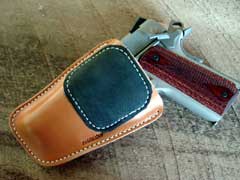
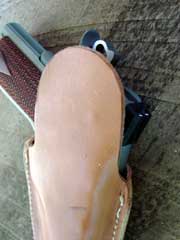

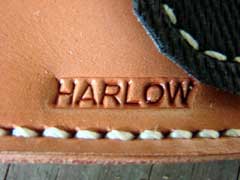
The Harlow holster is a very smart design; simple,
efficient and versatile.
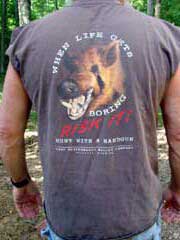
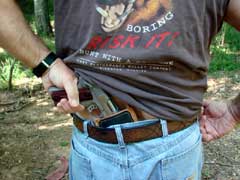
Harlow holster worn in the small-of-back position.
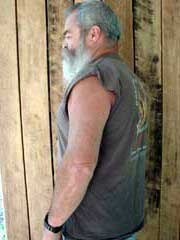

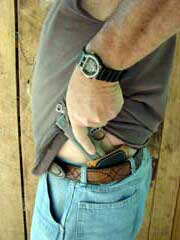
Harlow holster worn in the strong-side position.
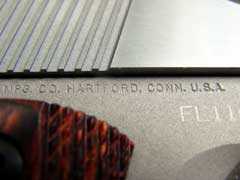
|
  
Got something to say about this article? Want to agree (or
disagree) with it? Click the following link to go to the GUNBlast Feedback Page.
|
Click pictures for a larger version.
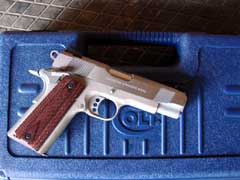
Colt's Lightweight Commander XSE..
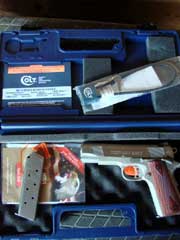
Gun comes with hard case, two magazines, lock and
instructions.
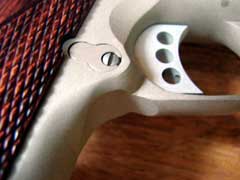
XSE is relieved behind the trigger guard to facilitate a
higher grip on the weapon.
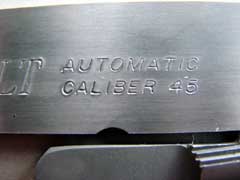
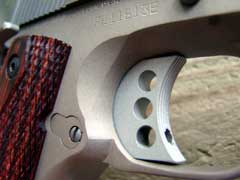
Lightweight trigger with overtravel screw.
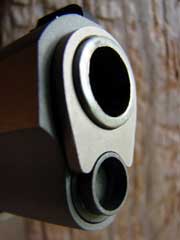
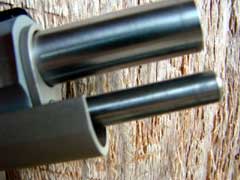
Stainless steel recoil spring guide rod.

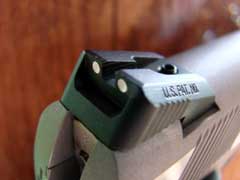
Sights are a highly visible, no-snag design.
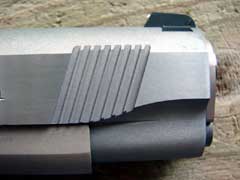
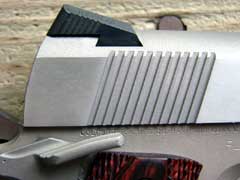
Slide is serrated front and rear for a positive grasp.
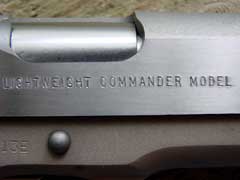
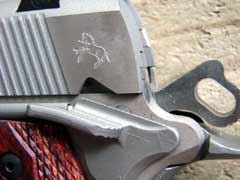

Ambidextrous safety is a welcome feature for a Southpaw
like Jeff.
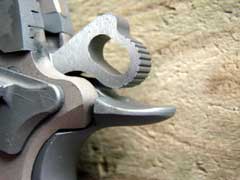
Rowell-type hammer & beavertail grip safety.
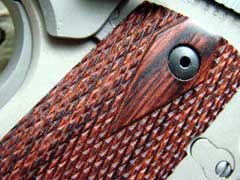
Cocobolo grips are checkered in a "double
diamond" pattern.
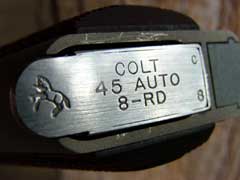
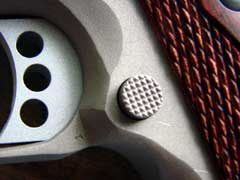
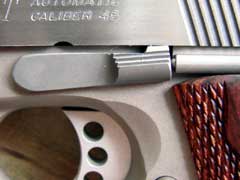
Magazine release (top) & slide release (bottom).
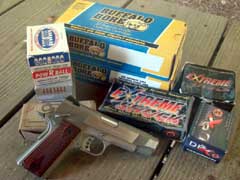
The Lightweight Commander was acceptably accurate and
100% reliable, as befits a fighting pistol.
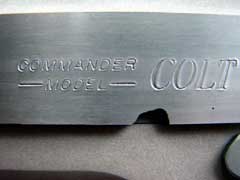
|
![]()